| Home | Nature Weekly Index |
18 May 2025 | Queen of Philippines | Mussaenda Hybrids |
From my balcony, I observe the park adjacent to my residence, where rows of closely planted Mussaenda species line the walkway. These plants have been cultivated in the park for several years, succeeding the previously planted Tecoma species. The Mussaenda species are distinguished by their large, vibrant sepals, making them notable ornamental plants. The park features four types of Mussaenda species or hybrids, categorized by the colour of their enlarged sepals: red, white, pink, and orange (Fig. 1).
| (a) Mussaenda erythrophylla | (b) Mussaenda philippica 'Aurorae' | (c) Mussaenda philippica 'Dona Luz' | (d) Mussaenda philippica 'Marmalade' |
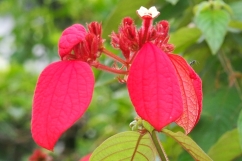 |
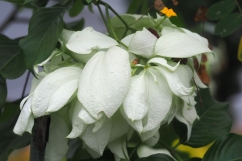 |
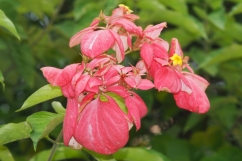 |
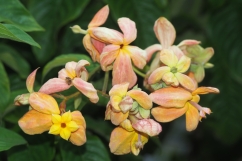 |
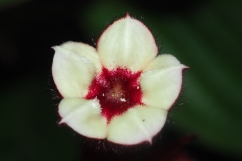 |
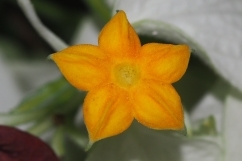 |
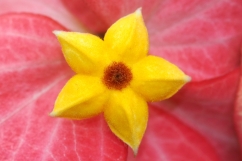 |
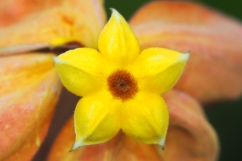 |
| Fig. 1 (a-d): Mussaenda species and hybrids in a nearby park | |||
The sepals of Mussaenda species, which are often mistakenly identified as bracts, form part of the flower and are typically green in colour. In contrast, bracts are modified leaves. Detailed illustrations of the sepals and bracts of Mussaenda species can be found on the Botany Brisbane website. An example of a plant commonly found in Singapore that features colourful bracts is Bougainvillea glabra (Paper Flower).
I have currently designated the plant with red sepals as Mussaenda erythrophylla (Red-leaved Mussaenda), and those with other colours as Mussaenda philippica (Queen of Philippines). This naming convention is also applied by the iNaturalist website. In 1998, more than 20 Mussaenda hybrids had already been developed from the crossbreeding of Mussaenda philippica with Mussaenda erythrophylla [1].
The NPark's Flora & Fauna Web utilizes a slightly different naming convention for the hybrids, as assessed on 18 May 2025:
- Red sepals: Mussaenda 'Dona Eva'
- White sepals: Mussaenda philippica 'Aurorae' (White Mussaenda, Tropical Dogwood)
- Pink sepals: Mussaenda erythrophylla 'Dona Luz'
- Orange sepals: Mussaenda 'Calcutta' (Buddha's Lamp)
The identification of the plant with white sepals is undisputed. The nomenclature for the one with red sepals should be reasonably straightforward based on available online information. However, I have not found any authoritative sources regarding the names of these hybrids.
| 10 May 2025 | 17 May 2025 |
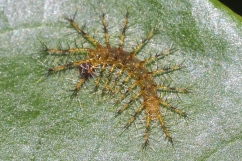 |
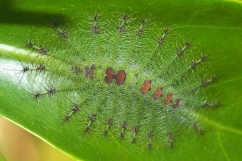 |
| Fig. 3: Caterpillar of Green Baron (Euthalia adonia pinwilli) butterfly | |
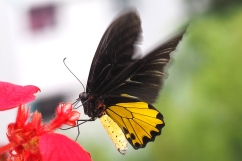 |
| Fig. 2: Common Birdwing (Troides Helena Cerberus) butterfly |
While studying the Mussaenda hybrids in the park this week, I observed a large yellow-black butterfly (Fig. 2) fluttering among the flowers of Mussaenda erythrophylla. A subsequent online search confirmed that it was a Common Birdwing (Troides Helena Cerberus) butterfly. Although I had encountered this species previously, capturing a quality image proved challenging as the butterflies were constantly in motion. In this instance, I took 31 photographs and managed to select 4 images for display on my website. Furthermore, while examining a parasitic plant, Dendrophthoe pentandra (Malayan Mistletoe) on a Mussaenda philippica, I discovered a second-instar caterpillar (Fig. 3) of the rare Green Baron (Euthalia adonia pinwilli) butterfly on one of the mistletoe leaves.
Reference:
[1] Alejandro GJD, Meve U, Liede-Schumann S. A taxonomic revision of Philippine Mussaenda (Rubiaceae, Mussaendeae). Annals of the Missouri Botanical Garden 2016;101(3):457-524. | Read article |